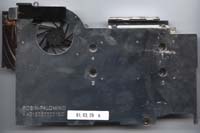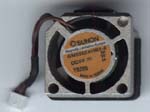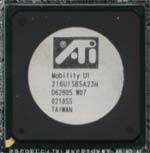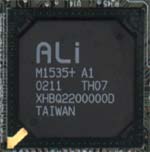Compaq Presario 900 1500+: The Radeon IGP Goes Mobile
by Matthew Witheiler on August 15, 2002 1:26 AM EST- Posted in
- Laptops
Construction - Under the Hood
We already know that the Compaq Presario 900 makes use of the Radeon IGP northbridge but what powers the rest of the Presario 900? Our test system came with a mobile Athlon XP 1500+ (1.3GHz) CPU, 256MB DDR memory, a 20GB hard drive, and an internal DVD/CD-RW drive.
The mobile Athlon XP processor is simply a Thoroughbred based Athlon XP desktop processor with PowerNow powersaving features enabled. We discussed PowerNow technology a while back, but as a refresher it allows the CPU to dynamically adjust its operating frequency and voltage according to the needs of the tasks that the CPU is running. PowerNow has the ability to adjust the CPU speed and voltage from a variety of deferent steps. This is unlike the new SpeedStep technology found in mobile Intel Pentium 4-M processors which can only adjust their speed and voltage from two levels.
The difference between the mobile Athlon XP and the Athlon XP is similar to the difference between a mobile Pentium 4-M chip and a desktop Pentium 4 chip with one big exception. The mobile Pentium 4-M chips are produced in a smaller package than the desktop Pentium 4 chips, making it easier to design a cramped notebook around the processor. The mobile Athlon XP, on the other hand, remains packaged in the same socket-A package that the desktop is packaged in. This leaves notebook designers with the difficult task of fitting the large CPU on a small notebook motherboard.
Thankfully things should get easier soon as AMD begins to manufacture SFF mobile Athlon XP CPUs. The SFF Athlons are produced in a much smaller package, making it easier to fit them in notebook designs.
The CPU is located deep inside the Presario 900 on the left side of the system. It actually sits in a standard socket-A socket. The chip is cooled via a fairly small heatsink connected to a fairly large fan. A thermal plate sits atop the mobile Athlon XP core. Heat is transferred from this plate to the heatsink surface via what appears to be a single copper heat pipe. A Sunon fan blows air across the heatsink surface, venting it on the unit's left side.
As we already discussed, the Compaq Presario 900 makes use of the Radeon IGP 320M northbridge. The northbridge is mounted fairly close to the CPU socket and is cooled somewhat passively thanks to a small aluminum heatsink that sits on top of the chip. Cool air likely wanders its way to the heatsink surface thanks to a small but deep fan mounted on the rear of the system. It is this fan that we can see on the back side of the Presario 900.
Removing the heatsink shows the Radeon IGP 320M, labeled an ATI Mobility U1 chip. The surface of the chip is partially metal to facilitate brining heat up from the 320M core up to the heatsink surface. The chip is fairly small considering all the functions it must perform (which we discussed in the second page of this review).
Directly below the CPU socket lies the ALi M1535+ southbridge that the Presario 900 uses. This chip features an integrated two channel ATA 100 IDE controller, 2 USB host controllers each capable of driving 3 USB 1.1 ports, hardware SoundBlaster Pro/16 compatible audio, and a Super I/O controller. Compaq likely chose the ALi solution over a SiS one simply because of price.
Found under the PCMCIA bracket are two more chips. The first of these is a TI PCI1410 PC card controller that enables the Presario 900's single PCMCIA slot. The second is a RealTek RTL8139CL LAN controller which power the system's ethernet port.



















0 Comments
View All Comments